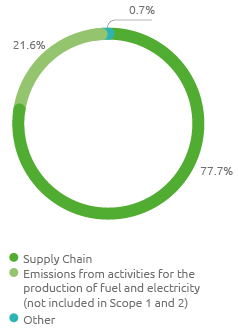Other indirect GHG emissions (Scope 3)
Scope 3 emissions (%) 2020

Aware of the impact created along its entire value chain and convinced of the importance of shared action to reduce climate-changing emissions, Snam has been calculating its Scope 3 emissions according to the GHG Protocol for years and reports them in the CDP Questionnaire (formerly the Carbon Disclosure Project). This year, this reporting has also been included in this document, except for the category related to investments, due to the timing of data validation by the participated companies, which historically represent about 50% of the total Scope 3 emissions.
The other most representative categories are those related to the supply chain and those associated with fuel and energy production.
During the year, Scope 3 emissions amounted to approximately 433 thousand tonnes of CO2eq, a figure recalculated by including the 8 emission categories applicable to Snam, with a 31% reduction compared to the 2019 figure due to a different nature of supplies and a reduction in emissions for business travel due to the health emergency. On this front, Snam is implementing additional initiatives to promote a culture aimed at saving energy and minimising the indirect emissions associated with the Group’s activities, including the adoption of green procurement criteria for the procurement of goods and services, sustainable mobility initiatives and all activities aimed at saving energy by employees (company shuttles, public transport concessions, smart working and the use of videoconferencing systems for meetings), as well as participation in the CDP Supply Chain programme.
The Scope 3 emissions categories are derived from the GHG Protocol and are grouped into three macro-classes:
I) Supply chain, i.e. emissions from Purchased goods and services, Capital goods, Upstream transportation and distribution, Waste generated in operations and Upstream leased assets;
II) Emissions from Fuel-and-energy-related activities (not included in Scope 1 or 2);
III) Other, which includes business travels and employee commuting.